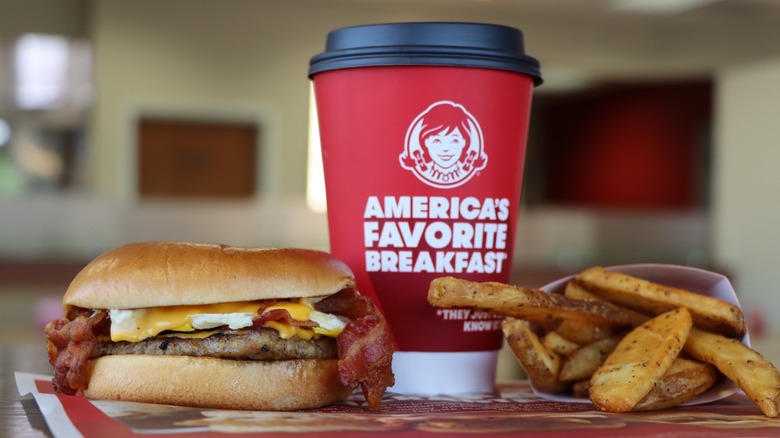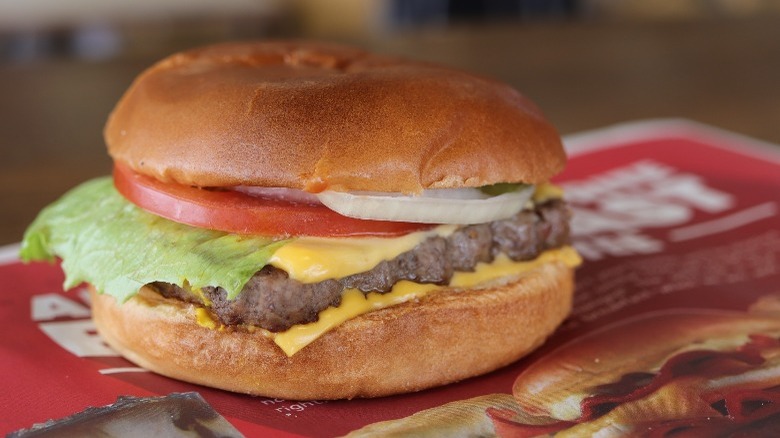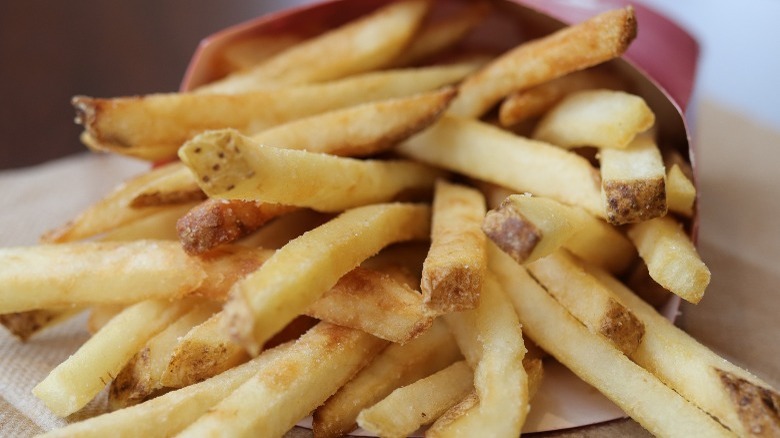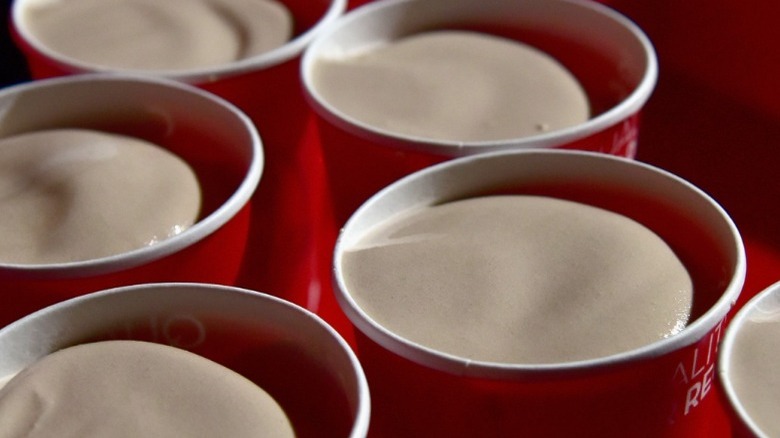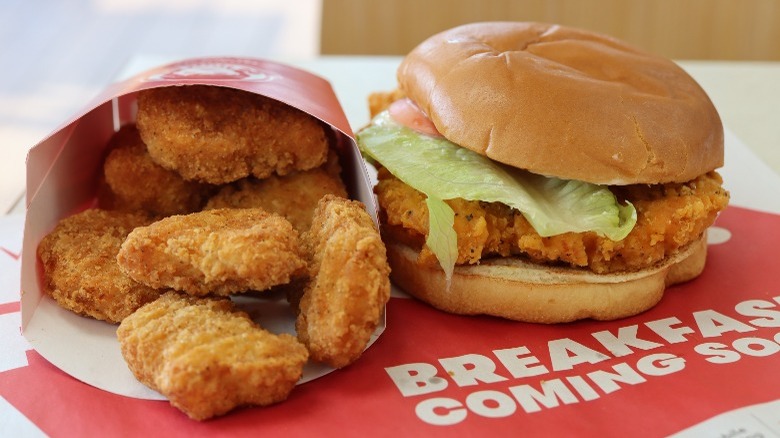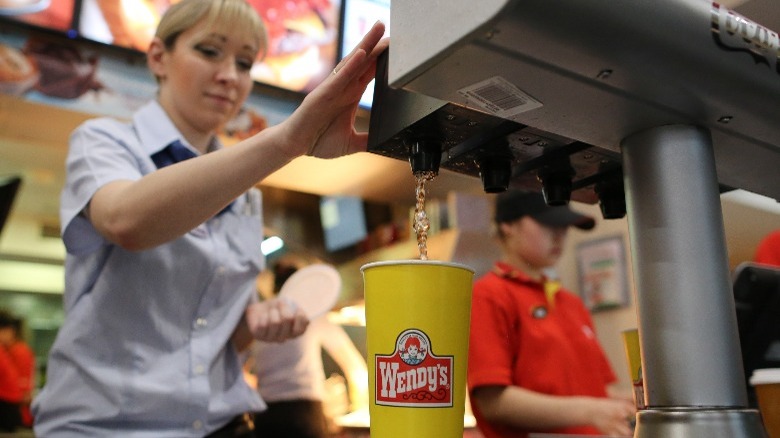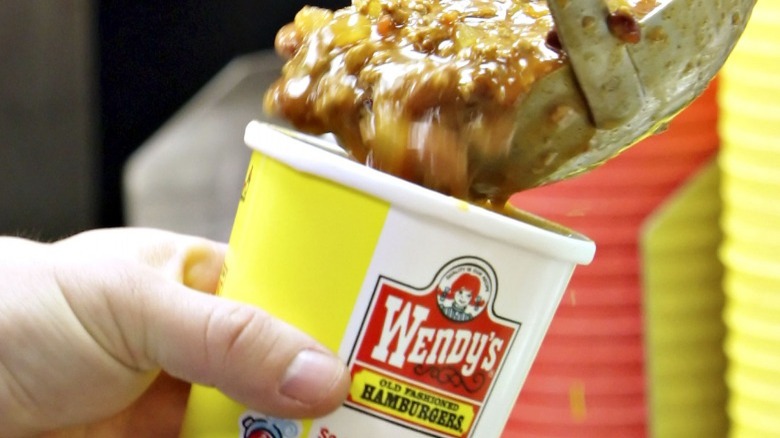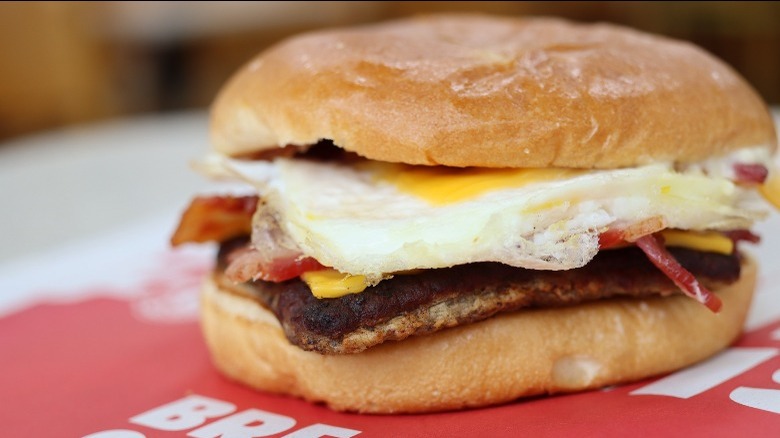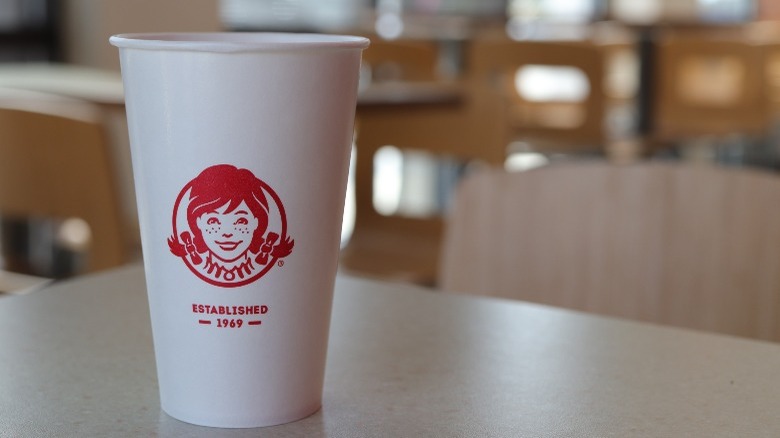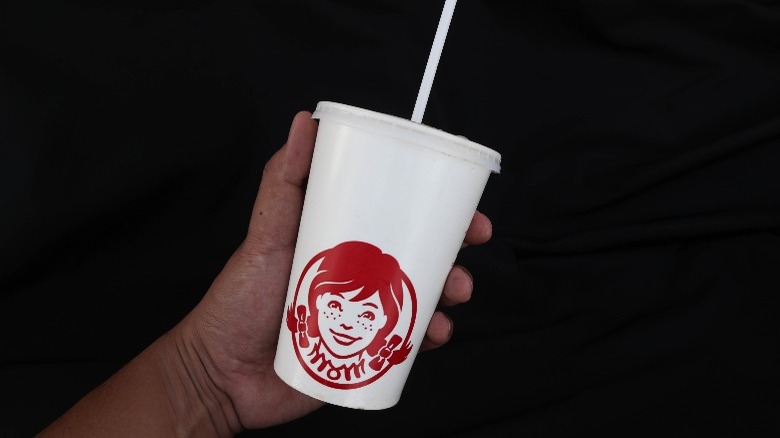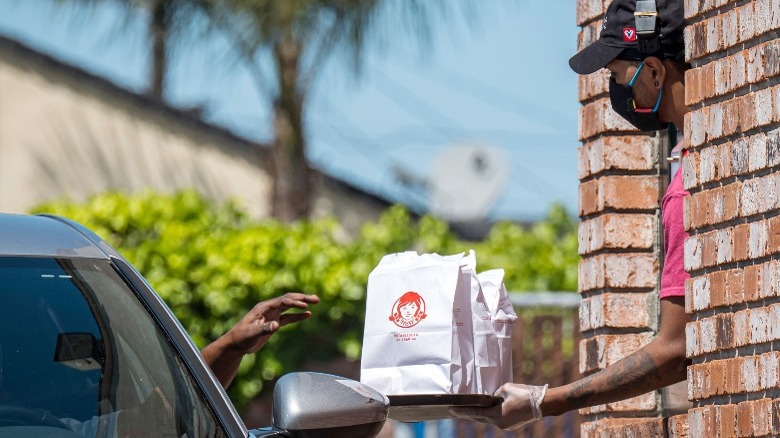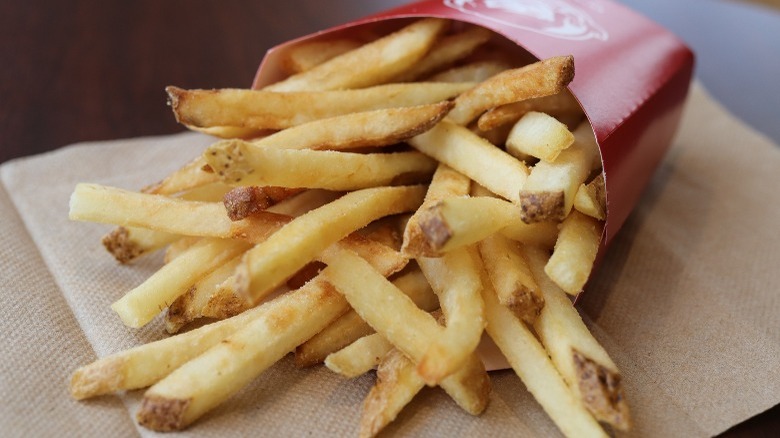We Finally Know Why Wendy's Is So Cheap
With their square, fresh, never-frozen burgers, Wendy's is a fast food icon. They have the beef, the chicken, the fries, and more. The Frosty beacons to all who can't decide between ice cream and a milkshake, and Wendy's is one of the few fast food joints that consistently offers salads. There's a lot to love, and their menu is literally made to crave. Wendy's has a secret or two to share, though, including the business practices and tricks behind the best bargains on the menu.
Do you know why your Jr. Bacon Cheeseburger is so affordable? Have you guessed what keeps a franchise from going under when they offer incredible deals on breakfast sandwiches? Do you know the cold truth at the heart of the Frosty machine? There are a lot of moving parts behind the price tags, and we're ready to share them. This is how Wendy's manages to sell their product for so cheap.
Low prices draw customers
Lower prices incentivize consumers to buy more. Think of it this way: You won't stop at a gourmet restaurant every day if you're keeping to a strict budget, but spending a couple bucks on a burger and fries once a day doesn't seem awful. It's a fairly affordable luxury, and you can get a lot more $2 burgers than $20 steaks. So long as the restaurant makes more than the cost of the burger, even if it isn't much, this system works. Even low profit margins translate to big profits when customers buy enough.
Wendy's doesn't need you to pay $20 for a burger once a month if you buy 10 cheaper burgers over four weeks. It's all about the scale, according to the BBC. To be fair, Wendy's doesn't offer a dollar menu anymore, but their value meals and menu items follow the same principle (via Reuters). If you can convince a lot of people to buy a lot of a cheap product, nibbles of profit turn into a full meal.
French fries play a big part in low prices at Wendy's
The potato is a humble, but beloved vegetable. It's also about as cheap as the dirt it grows in when bought in bulk. A farm may lose a contract with a fast food company if someone else sells their potatoes for a penny or two less per pound.
This contributes to why fries are ridiculously cheap to make, and we all know how popular they are. Don't you feel like you're missing out if you buy a burger and skip the fries? These golden children of the deep fryer have a huge profit margin (via The Wall Street Journal). Fast food fries cost very little to make, and they often sell for more than some of the cheapest burgers on the menu. The Jr. Cheeseburger costs 99 cents at most locations. So do the value-sized fries. A Jr. Bacon Cheeseburger sells for $1.99, and a medium fry will cost the same. Beef, bacon, and cheese all cost much more than their equivalent weight in potato, and french fries take less time and effort to prepare than a burger.
You love fries, and so does Wendy's.
They waste no Frosty mix
The adage says if you waste not, you will want not. Besides the fact that it sounds like something a certain green space wizard might suggest, it's a useful saying. It's a concept most fast food restaurants buy into, and Wendy's is no exception. Every second is precious, and you've probably seen an employee talking to someone via the drive-thru speaker through the window as they process your payment and arrange drinks for the next order.
Wendy's applies this principle to other business resources, though, that may surprise you. Your Frosty, for example, may be on its second life. What don't you know about your Frosty? A former Wendy's employee explained on reddit how the mix for Frostys arrives in a milk-like consistency and transforms into the shake-like ice cream mixture when it's run through a machine. Here's the catch: at the end of the day, employees clean that machine. Any mix left inside goes in a bucket, which goes in the freezer, and then it goes back in the machine the next day. Early diners who order Frostys get treats that have a more seasoned outlook on life.
The fact that they're not literally throwing that precious Frosty mix down the drain means they can charge even less for them, and we're not mad at that.
Wendy's Biggie Bags hold big profits
Combo meals like the Biggie Bags sound cheap because they come with a lot of different items. Apart from the sandwich, though, the items are all incredibly inexpensive to make, so it's a cheap lunch for you and a payday for Wendy's..
If you really want four small portions of four different foods, because variety is the spice of life, then Wendy's bargain combo meals are still a good investment for the experience. That said, it's important to remember how they make their money, and still sell you the goods for fairly cheap.
The sizes are often smaller than you realize. The 4 for $4 deal, for example, includes not small, but junior fries. They are literally smaller than small. The drink is actually small, and you get four whole chicken nuggets with your sandwich. Remember the golden rule of restaurants, which is that soft drinks have a huge profit margin, even when sold for less than the a la carte price. The Biggie Bag costs a dollar more and delivers more meat on your sandwich along with a small fry. Wendy's gets a lot from that extra dollar. It's still a bargain meal, but it has major benefits for Wendy's.
Wendy's pays low, hourly wages
The average hourly rate for a Wendy's employee is under $10 per hour, according to PayScale. While managing positions make more, few earn more than $15 an hour, and there are fewer managers compared to cashiers and cooks. Labor is part of business costs, and the price of labor goes into the price of your burger.
These wages aren't accidental, and they're built into Wendy's operating methodology. It's such an issue that rising wages and staffing shortages in Wendy's pay grade has inspired the company to invest in labor-saving alternatives. Investors Business Daily says in 2016 they announced a trial run of self-service kiosks for ordering in-store, which would free the workers to focus on preparing food instead of serving as cashiers. It could also open the possibility of cutting back minimum staffing requirements.
Essentially, Wendy's makes cheap food through cheap labor, and that cheap labor is so important to their business model that they're paying for new technology to counteract rising labor costs.
They use leftover burgers in their chili
Leftovers are great. The week after a major holiday is like living reruns of a fantastic dinner. Maybe your parents even used leftovers to make other dishes. After all, leftovers are the heart and soul of the American casserole. We've all had leftovers, and if you enjoy Wendy's chili, you may like leftovers even more than you realized. It turns out Wendy's chili has an untold truth all its own.
Wendy's leans into this tradition by using leftover burger meat to make their chili. According to multiple former employees who volunteered to discuss their old jobs on reddit, the chain's chili comes from leftover burgers. The burgers that don't sell are chopped and frozen for use in a later day's chili. This means if the whole idea of meat that's fresh and never frozen is what attracts you to the restaurant, you should understand the chili is an exception to the rule.
The good news is that, by giving aging burgers a new career path, Wendy's may reduce the risk of harried managers trying to sell meat that has been waiting a little too long as part of your premium sandwich. And of course, the chili is a lot cheaper than in would be if they used fresh meat.
Wendy's starts cheap so you'll pay more later
If you visit Wendy's often, you know the truth: They aren't always cheap. A premium sandwich can cost over $6 on its own, easily. The deals keep rolling through, though, and no one can resist the idea of a bargain. What happens, though, once the sale has ended?
Wendy's has great limited time deals, like their special offer for a honey butter chicken breakfast sandwich for just $1.99. At one point, they offered some breakfast sandwiches for just $1 each, and you can sometimes snag any size fry for $1, too. These deals have all ended for the moment, but there's always another discount on the horizon.
These sales don't just save you money, they help boost Wendy's revenue. First, the bargain convinces you to stop at Wendy's and make an initial purchase. If you like what you eat, you may go multiple times to take advantage of the offer, and you probably aren't going to buy a lonely $1 fry without another item to keep it company. When the deal ends, do you refuse to eat Wendy's breakfast sandwiches ever again? Doubtful. You tried it because it was cheap, and if you liked it, you'll probably splurge on it again at a later date for a higher rate.
Not all food at Wendy's is really fresh
We know the beef isn't frozen before it goes on a sandwich. But Wendy's doesn't make all of its food from scratch, despite the pretty pictures of fresh ingredients in their ads.
The lemonade at Wendy's is not a fresh-squeezed brew put together with whole fruit in each restaurant's kitchen. A Tik Tok user called Naay filmed the actual process, and the only potential fruit was in the puree added for the strawberry variation. According to the video, employees add Hubert's lemonade base mix to a literal bucket of tap water, stir it up, and add flavored syrups to individual cups for additional flavor options.
You may have tried a powdered lemonade mix with tap water at home. It isn't dangerous or unsanitary, but you should understand that one of the reasons Wendy's is cheaper than a local, boutique restaurant that makes its lemonade from scratch is that, well, Wendy's takes the pre-packaged path.
They subsidize bargains with soda
Most of your soft drink is water, and the syrup and carbonation come cheap. It's a well-known fact that restaurant soda costs the customer far more than it costs the restaurant to make (via Fortune), which makes the drinks menu a boon for any Wendy's.
You may not realize a small soft drink costs more than the cheapest cheeseburger, either. A small drink sets you back $1.69 and a Jr. Cheeseburger, the cheapest burger on the menu at the time of writing, only costs 99 cents. That gives other products that cost more to make — like a burger — a little wiggle room, because if the customer buys a drink with their cheap burger, Wendy's still wins.
Even more importantly, the consistent profit margin of soft drinks supports all those bargains that Wendy's is so well-known for. It's part of Loss Leader Strategy, which draws customers away from competitors with a cheaper version of the competitor's product. In short, the value menu woos the frugal customers, and the marked-up soft drinks make the money.
Wendy's needs drive-thru sales
The in-store counter may be the smiling face of Wendy's, but its lifeblood pumps through the drive-thru. Speed and volume is the key to profit in the fast food industry, and if you've ever been stuck in a slow drive-thru, you instinctively know it isn't functioning the way it should. These lanes are for speed, and when the team inside is equipped to do their jobs well, they bring the money flying through the order window.
The same principles that govern cheap burgers work here. too. Drive-thrus help keep food cheap by increasing sales by volume. A lot of cheap food sold with a low profit margin can make big bucks when you sell enough of it. The same principle lowers the pressure on individual customers to shell out, because someone ahead or behind the bargain shopper will choose premium items. It's so important to their business model, they're considering drive-thru-only locations (via Restaurant Business).
The fries at Wendy's can sit for a while
The big selling point for Wendy's new hot and crispy fries is that they're a better product for the consumer. It isn't a big deal for restaurants to release food that tastes better for their customers, but there's some particular wording you should note. These fries aren't just hotter and crispier fresh out of the fryer. They are designed to stay hot and crispy for 30 minutes. This is a strange brag for a company that likes to talk about how fresh all of their food is.
How does this make Wendy's food cheaper? The new fries could potentially cut down how many they have to throw away. It's a strategy that aims to work around the fact that fries may not be terribly fresh. If they taste better longer, they have more time to wait. Honestly, if your fries taste good, you won't complain. If the fries deliver on their promise, then a one-time curiosity-driven purchase may make you think twice about skipping fries next time you visit. You're much more likely to spend money on something you know will be good, right? They're made to crave.
